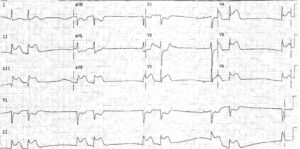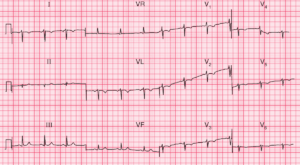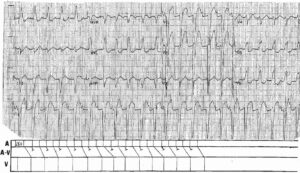This post is an answer to the ECG Case 284
- Rate: 42 bpm
- Rhythm:
- Irregular
- No visible p waves
- Axis: Normal
- Intervals:
- QRS – Prolonged (200ms)
- QT – 760ms (QTc Bazette 640 ms)
- Segments:
- ST Elevation in lead aVR
- ST Depression in leads II, III, aVF, V2-6
- Additional:
- Deep T wave inversion in leads II, III, aVF, V1, V3-5
- Osbourne-J waves best seen in infero-lateral leads
- ST morphology in lead V1 has ‘brugada’ appearance
Interpretation
Main differentials for these ECG features include:
- Hyperkalaemia – known T1DM altered conscious level could be associated with DKA
- Metabolic disturbance – severe acidaemia
- Hypothermia – slow AF, J waves
- Drug toxicity – ? sodium channel blocker – ‘Brugada’ pattern in V1
What happened next ?
The patient was found obtunded and further history suggested a drug ingestion including a tricyclic antidepressant and paracetamol. He was severely hypothermic, core temp 25°C, with a significant metabolic disturbance:
- pH 6.9
- K 7.2
- HCO3 7
- U 10.6
- Creat 267
- Lactate 26
The patient was successfully resuscitated but unfortunately following his ICU admission he developed multi-organ failure and failed to respond to organ replacement and increasing vasopressor administration.
READ MORE: ECG Interpretation – All you need to know




